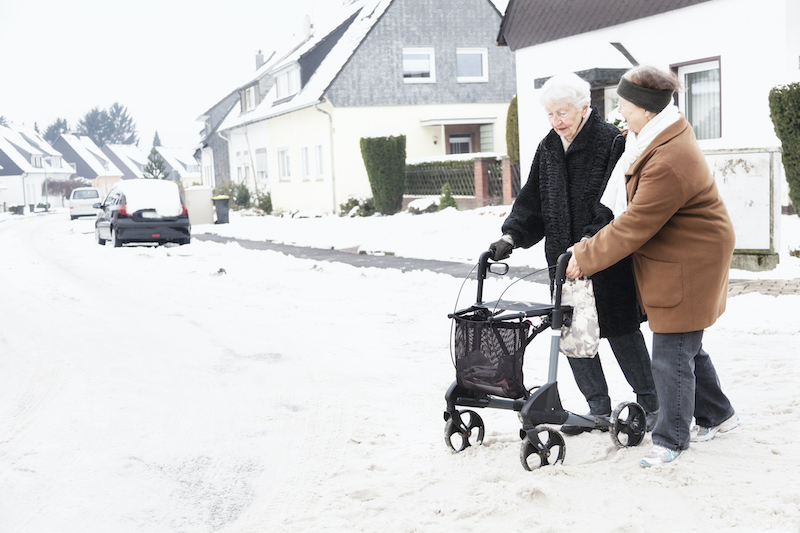Each year, one in three people aged 65 and older suffer a fall, and cold weather and icy conditions are major contributors to this ratio. In fact, falls are the leading cause of injury and injury-related death in seniors, which is why we’ve compiled this list of fall prevention tips.
Because the physical toll of falling is so heavy for seniors, navigating slippery conditions requires more preparation and mindfulness than it does for younger people.
Preparations to Avoid Falls
Seniors should talk to their physician about their risks for falls. This includes any health challenges or medications that may affect balance or cause drowsiness, including a review of any over-the-counter medications being taken by the senior.
Keep driveways and sidewalks clear. Seniors need to notice whether melted snow or ice has refrozen, and they must own footwear with good traction – shoes or boots with rough-textured soles. They must watch for compacted snow, which is always slicker than fresh-fallen snow that has not been walked on yet. A plan should be in place for family or neighbors to assist in clearing walkways of any ice and snow during the winter months.
Practice good exercise habits. As we age, our walking gait and balance tends to slow and decline, and our muscles lose their strength and elasticity. To help prevent falls, seniors should maintain regular moderate physical activity levels – which include endurance, strength, flexibility and balance exercises – to improve overall health and their ability to walk safely.
Get regular eye exams. Old or ineffective eyeglasses increase the risk for a fall, particularly if the senior has difficulty detecting icy conditions.
Dress warmly when venturing outdoors in the winter. As we age, our body struggles to retain heat, and hypothermia can set in quickly. So even if it is just a 30-second trip to the mailbox, don’t attempt it in your pajamas, robe and slippers.
Seniors should always carry a cell phone or other alert device so help can be summoned quickly. This is a good idea any time of the year! There are new safety devices, including medical alert watches, that provide the following options:
- Built-in automatic fall detection
- Waterproof design
- Press or speak for help from an emergency response operator
- GPS tracking of the senior’s location
- Medication reminders for seniors
11 Fall Prevention Tips
- Be careful getting out of a car. Plant both feet firmly on the ground before moving and use the door frame for support.
- Stay on cleared paths and sidewalks. Walking between cars or any place that requires squeezing between obstacles can be hazardous, as can ice on grassy slopes.
- Be aware of uneven ground and low spots. These areas may hold water that can freeze.
- Check steps and driveways for hazardous conditions. The steps outside a home may no longer be level, and driveways poured with a slight slant for drainage can be dangerous if they become icy.
- If the weather is bad or the ground or pavement is not safe, exercise indoors. Fear of falling can make a person more likely to fall if they hesitate or overreact to a perceived hazard.
- Don’t rush when walking. Try to identify possible slippery surfaces just ahead, and take short steps with toes pointed slightly outward to maintain a more stable base. Try to place each foot flat on the ground before taking the next step.
- Avoid carrying items while walking in icy conditions.
- Use handrails when available.
- Clean off shoes after walking in wintery conditions.
- Watch for black ice, particularly in dark or shaded areas.
- If you have fallen in the past, think about what contributed to the fall and determine how to avoid that situation in the future.
Want to find out more?
If you’d like to stay up to date with Bethesda Health Group, sign up here to receive our blog and newsletters!
"*" indicates required fields
Related Articles
Want to find out more?
If you’d like to stay up to date with Bethesda Health Group, sign up here to receive our blog and newsletters!
"*" indicates required fields


